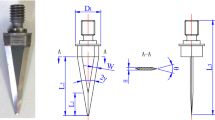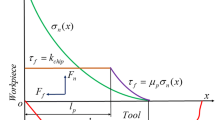Abstract
Nomex honeycomb composite material has a wide range of applications due to its lightweight, high strength, and low-cost advantages. Using ultrasonic-assisted cutting to process it can effectively overcome the shortcomings of traditional high-speed milling. This paper takes the ultrasonic cutting acoustic system of disc cutter as the research object and studies the influence of the cutting force and temperature of the cutter on the stability of the acoustic system utilizing theoretical modeling and experiments, mainly discussing the effect of force load and temperature change on the resonant frequency and amplitude of acoustic system. According to the equation of motion of ultrasonic cutting, the cutting force model of the disc cutter is established, and the theoretical model of temperature with the resonance frequency and amplitude of the ultrasonic cutting acoustic system of the disc cutter is derived. The experiments on the influence of force load and temperature on the stability of the acoustic system are carried out, respectively. The experimental results show that with the increase of cutting force, the resonance frequency of the ultrasonic cutting acoustic system shows an upward trend, and the amplitude shows a downward trend; with the increase in temperature, both resonance frequency and amplitude decrease. In addition, the change in the inclination angle of the disc cutter during machining will also lead to the change in resonance frequency and amplitude of the acoustic system. The experimental results show the cutter’s inclination angle when the machining effect is the best is 6°. This study provides a certain guiding significance for improving the stability of the disc cutter ultrasonic cutting system.

















Similar content being viewed by others
Data availability
This article contains all the data gathered or analyzed during this study.
References
Kececi E, Asmatulu R (2017) Effects of moisture ingressions on mechanical properties of honeycomb-structured fiber composites for aerospace applications. Int J Adv Manuf Technol 88(1–4):459–470. https://doi.org/10.1007/s00170-016-8744-8
Roy R, Park S-J, Kweon J-H, Choi J-H (2014) Characterization of Nomex honeycomb core constituent material mechanical properties. Compos Struct 117:255–266. https://doi.org/10.1016/j.compstruct.2014.06.033
Park YB, Kweon JH, Choi JH (2014) Failure characteristics of carbon/BMI-Nomex sandwich joints in various hygrothermal conditions. Compos B Eng 60:213–221. https://doi.org/10.1016/j.compositesb.2013.12.035
Liu LQ, Meng P, Wang H, Guan ZW (2015) The flatwise compressive properties of Nomex honeycomb core with debonding imperfections in the double cell wall. Compos B Eng 76:122–132. https://doi.org/10.1016/j.compositesb.2015.02.017
Karakoc A, Freund J (2012) Experimental studies on mechanical properties of cellular structures using Nomex (R) honeycomb cores. Compos Struct 94(6):2017–2024. https://doi.org/10.1016/j.compstruct.2012.01.024
Zhou H, Xu P, Xie S, Feng Z, Wang D (2018) Mechanical performance and energy absorption properties of structures combining two Nomex honeycombs. Compos Struct 185:524–536. https://doi.org/10.1016/j.compstruct.2017.11.059
Gang L, Ke Y-L (2007) Study on clamping method for paper honeycomb based on magnetic field and friction principle. J Mater Process Technol 190(1–3):65–72. https://doi.org/10.1016/j.jmatprotec.2006.10.052
Abbadi A, Tixier C, Gilgert J, Azari Z (2015) Experimental study on the fatigue behaviour of honeycomb sandwich panels with artificial defects. Compos Struct 120:394–405. https://doi.org/10.1016/j.compstruct.2014.10.020
Meruane V, delFierro V (2015) An inverse parallel genetic algorithm for the identification of skin/core debonding in honeycomb aluminium panels. Struct Control Health Monit 22(12):1426–1439. https://doi.org/10.1002/stc.1756
Sun JS, Dong ZG, Wang XP, Wang YD, Qin Y, Kang RK (2020) Simulation and experimental study of ultrasonic cutting for aluminum honeycomb by disc cutter. Ultrasonics 103.https://doi.org/10.1016/j.ultras.2020.106102
Zhang L, Dong J, Cohen PH (2013) Material-Insensitive feature depth control and machining force reduction by ultrasonic vibration in AFM-based nanomachining. IEEE Trans Nanotechnol 12(5):743–750. https://doi.org/10.1109/tnano.2013.2273272
Qiu KX, Ming WW, Shen LF, An QL, Chen M (2017) Study on the cutting force in machining of aluminum honeycomb core material. Compos Struct 164:58–67. https://doi.org/10.1016/j.compstruct.2016.12.060
Foo CC, Chai GB, Seah LK (2007) Mechanical properties of Nomex material and Nomex honeycomb structure. Compos Struct 80(4):588–594. https://doi.org/10.1016/j.compstruct.2006.07.010
Seemann R, Krause D (2017) Numerical modelling of Nomex honeycomb sandwich cores at meso-scale level. Compos Struct 159:702–718. https://doi.org/10.1016/j.compstruct.2016.09.071
Xiang DH, Wu BF, Yao YL, Liu ZY, Feng HR (2019) Ultrasonic longitudinal-torsional vibration-assisted cutting of Nomex (R) honeycomb-core composites. Int J Adv Manuf Technol 100(5–8):1521–1530. https://doi.org/10.1007/s00170-018-2810-3
Babitsky VI, Astashev VK, Meadows A (2007) Vibration excitation and energy transfer during ultrasonically assisted drilling. J Sound Vib 308(3–5):805–814. https://doi.org/10.1016/j.jsv.2007.03.064
Cardoni A, MacBeath A, Lucas M (2006) Methods for reducing cutting temperature in ultrasonic cutting of bone. Ultrasonics 44:E37–E42. https://doi.org/10.1016/j.ultras.2006.06.046
Oxley PLB (1989) The mechanics of machining. E. Horwood
Chen K (2016) The ultrasonic cutting heat of Nomex honeycomb composites is studied. Master’s Deg Thesis Hangzhou Dianzi Univ. https://doi.org/10.7666/d.D01269605
Guo ZF, Liu X, Yao SF, Yu BH, Hu XP, Ye HX (2022) Stability analysis and experimental research on ultrasonic cutting of wave-absorbing honeycomb material with disc cutter. Int J Adv Manuf Technol 120(1–2):1373–1383. https://doi.org/10.1007/s00170-022-08776-2
Funding
This study was funded by the National Natural Science Foundation of China (No. 51975173).
Author information
Authors and Affiliations
Contributions
Huawei Ji, Wenhui Xing, and Xiaoping Hu planned the research. Wenhui Xing, Fan Yang, and Bo Lv did the experiments. Anqi Qi wrote the paper and analyzed the data; Xin Wu and Jing Ni revised the paper.
Corresponding author
Ethics declarations
Ethical approval
None of the studies mentioned in this article contains any human participation. Also, no animals were harmed during these experiments.
Consent to participate
The authors consent to participate.
Consent for publication
The authors provide their consent to publish this article.
Competing interests
The authors declare no competing interests.
Additional information
Publisher's note
Springer Nature remains neutral with regard to jurisdictional claims in published maps and institutional affiliations.
Rights and permissions
Springer Nature or its licensor (e.g. a society or other partner) holds exclusive rights to this article under a publishing agreement with the author(s) or other rightsholder(s); author self-archiving of the accepted manuscript version of this article is solely governed by the terms of such publishing agreement and applicable law.
About this article
Cite this article
Ji, H., Qi, A., Xing, W. et al. Analysis of influencing factors on the stability of acoustic system for ultrasonic cutting with disc cutter. Int J Adv Manuf Technol 123, 3095–3108 (2022). https://doi.org/10.1007/s00170-022-10282-4
Received:
Accepted:
Published:
Issue Date:
DOI: https://doi.org/10.1007/s00170-022-10282-4




